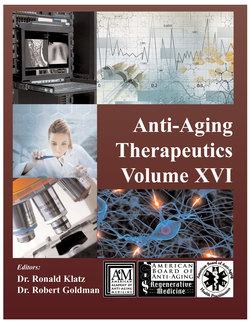Читать книгу Anti-Aging Therapeutics Volume XVI - A4M American Academy - Страница 35
На сайте Литреса книга снята с продажи.
RESULTS
ОглавлениеPearson Product-Moment Correlations
Age did not correlate significantly with any of the hormone levels, symptom domains, total endorsed symptoms, or grand MQ mean. Significant correlations between hormone levels and the 12 MQ symptom domains appear in Table 1. DHEA correlated significantly with the genitourinary domain (r=.30, p<.05). Estrone had a negative correlation with the musculoskeletal domain (r=-0.43, p<.012). FSH correlated significantly with the pulmonary domain (r=-.29, p<.05). Pregnenolone correlated significantly with the genitourinary (r=.40, p<.006) and immunological (r=.38, p<.008) domains. Testosterone correlated significantly with the total number of symptoms endorsed (r=-.34, p<.016) but with none of the 12 MQ symptom domains. TSH correlated significantly with the pulmonary (r=-.33, p<.03) and gynecological (r=-.39, p<.03) domains (Figure 2).
Table 1. Initial assessment – significant correlations of hormones with MQ symptom domains *Note all symptoms include genitourinary, musculoskeletal, immunological, pulmonary, and gynecological
| Hormone | Symptom Domain | r | P | Hormone Change |
| DHEA | Genitourinary | 0.30 | <0.05 | Increase |
| Estrone | Musculoskeletal | -0.43 | <0.012 | Decrease |
| FSH | Pulmonary | -0.29 | <0.05 | Decrease |
| Pregnenelone | Genitourinary | 0.40 | <0.006 | Increase |
| Immunological | 0.38 | <0.008 | Increase | |
| Testosterone | all symptoms | -0.34 | <0.016 | Decrease |
| TSH | Pulmonary | -.33 | <0.03 | Decrease |
| Gynecological | -.30 | <0.03 | Decrease |
Figure 2. Initial assessment – significant correlations of hormones with MQ symptom domains
However, given the large number (120) of correlations performed between hormone and symptom variables, a Bonferroni correction was applied with an experiment-wise significance level of p<.00045 required for interpretation of statistical significance. None of the hormones remained significantly correlated with a symptom domain after the Bonferroni correction.
Significant correlations between hormone levels and follow-up MQ symptom domains appear in Table 2. DHEA correlated significantly with the immunological domain (r=.65, p<.04). FSH correlated significantly with the neuropsychiatric (r=.56 p<.05) and musculoskeletal (r=.67, p<.013) domains. LH correlated significantly with the musculoskeletal domain (r=.59, p<.034). Free testosterone correlated significantly with the neuropsychiatric (r=.64, p<.019), musculoskeletal (r=.68, p<.01) and dermatologic (r=.57, p<.04) domains, and total testosterone correlated significantly with the immunological domain (r=.63, p<.028). Finally, TSH correlated negatively (r=-.62, p<.031) with the endocrinological domain. However, none of these correlations was significant after applying the Bonferroni correction for multiple comparisons, requiring p<.00045.
Table 2. Follow-up assessment
| Hormone | Symptom Domain Correlation(s) | Value, r | Value, p | Hormone Change |
| TSH | Endocrinological | -0.62 | <.031 | Decrease |
| LH | Musculoskeletal | 0.59 | <.34 | Increase |
| FSH | Neuropsychiatric | 0.56 | <.05 | Increase |
| Musculoskeletal | 0.67 | <.013 | Increase | |
| DHEA | Immunological | 0.64 | <.04 | Increase |
| Free Testosterone | Neuropsychiatric | 0.64 | <.019 | Increase |
| Musculoskeletal | 0.68 | <.01 | Increase | |
| Dermatologic | 0.57 | <.04 | Increase | |
| Total Testosterone | Immunological | 0.63 | <.028 | Increase |
Figure 3. Results of the follow-up assessment
Factor Analysis
A factor analysis of the MQ yielded 2 factors with eigenvalues > 1.0. The first factor had high loadings from the pulmonary, GI, cardiovascular, and immunological domains. The second factor had high loadings from all 3 neurologically related domains as well as the musculoskeletal and gynecological domains. The first factor correlated significantly with pregnenolone (r=.37, p<.019) and the second factor correlated significantly with TSH (r=.33, p<.034) [Fig 4].
Figure 4. A factor analysis of the MQ yielded 2 factors with eigenvalues > 1.0
A factor analysis of the hormone levels yielded 4 factors (Fig. 5). Factor 1 had high loadings from DHEA, progesterone, free testosterone, and total testosterone. Factor 2 had high loadings from FSH and LH. Factor 3 had high loadings from estrone and progesterone. The fourth factor had high loadings from pregnenolone and TSH. Factor 1 did not correlate with any of the symptom domains or with the symptom factors. Factor 2 correlated significantly with the endocrinological domain (r=-.47, p<.012). Factor 3 correlated significantly with the pulmonary (r=-.43, p<.035), musculoskeletal (r=-.43, p<.024), and genitourinary (r=-.49, p<.009) domains.
Figure 5. A factor analysis of the hormone levels yielded 4 factors
ANOVA and Regression Analysis
The one-way ANOVAs on the MQ symptom domains and the 2 MQ factors between the origin of menopause (age-related, surgery, disease) were not significant. The one-way ANOVAs on the MQ symptom domains and the 2 MQ factors between the younger (40-59) and older (>=60) subjects were not significant. A stepwise regression analysis to predict symptom domain factors from the 10 hormone levels was not significant. Similarly, a stepwise regression analysis to predict symptom domain factors from the 4 hormone level factors was not significant.
